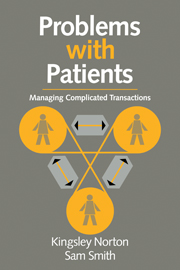Book contents
- Frontmatter
- Contents
- Foreword by Professor Paul Freeling, O.B.E.
- Preface
- Acknowledgments
- 1 Doctor–patient interaction
- 2 The clinical transaction
- 3 Interpersonal influences
- 4 The influence of past relationships
- 5 Contextual influences
- 6 Managing complicated clinical transactions
- 7 Interventions in complicated clinical transactions
- 8 Implications for the clinical setting
- 9 Implications for training
- Appendix I Clinical phenomena related to ‘problem patients’
- Appendix II Personality disorder
- References
- Index
Appendix I - Clinical phenomena related to ‘problem patients’
Published online by Cambridge University Press: 19 March 2010
- Frontmatter
- Contents
- Foreword by Professor Paul Freeling, O.B.E.
- Preface
- Acknowledgments
- 1 Doctor–patient interaction
- 2 The clinical transaction
- 3 Interpersonal influences
- 4 The influence of past relationships
- 5 Contextual influences
- 6 Managing complicated clinical transactions
- 7 Interventions in complicated clinical transactions
- 8 Implications for the clinical setting
- 9 Implications for training
- Appendix I Clinical phenomena related to ‘problem patients’
- Appendix II Personality disorder
- References
- Index
Summary
Somatisation
Somatisation is a tendency to express and communicate somatic distress and symptoms unaccounted for by pathological findings, to attribute them to physical illness and to seek medical help for them. Consequently, somatising patients are those who frequently complain of physical symptoms that either lack demonstrable organic bases or are judged to be grossly in excess of what one would expect on the grounds of objective medical findings (Lipowski, 1988). Such patients are commonly encountered in both primary and secondary care settings.
Somatisation, of course, does not imply that the patient does not have a concurrent physical or mental illness. On the contrary, in some cases it can actually coexist with, mask or be facilitated by such an illness (McFarland et al, 1985). Overall, it is the pattern of predominantly somatic rather than cognitive response to stress and related emotional arousal that is the common feature of somatising patients. Such highly somatic responders display a wide diversity of physical symptoms and psychological characteristics and have been shown to make greater use of health care services than do low somatic responders (Frost et al.1986). Somatising patients pose obvious problems for the doctors seeking to treat them, who might wish to avoid colluding in the management of a physical illness they regard as non-existent and yet they may be unable to convince their patients of the accuracy of this assessment.
Somatisation does not encompass all physical symptoms unaccounted for by demonstrable physical illness.
- Type
- Chapter
- Information
- Problems with PatientsManaging Complicated Transactions, pp. 155 - 160Publisher: Cambridge University PressPrint publication year: 1994



